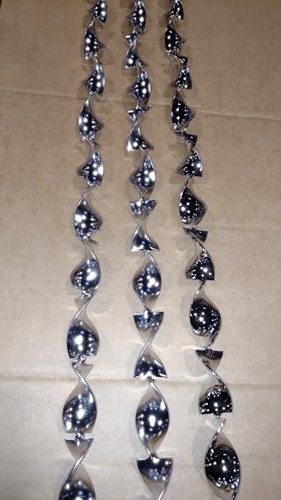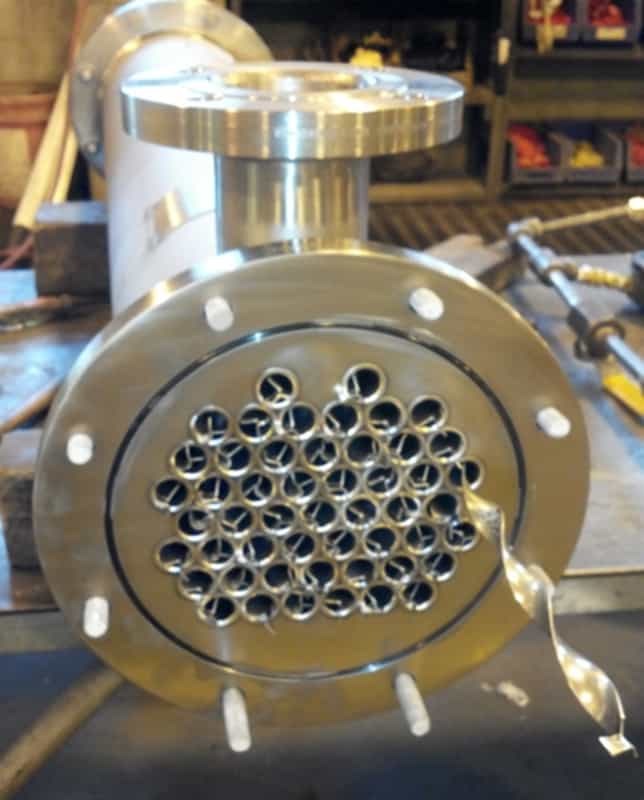The path a liquid travels through a shell and tube heat exchanger is pretty simple. One fluid travels through the tubes, while another travels through the surrounding shell. Since all sides of the tubes are in contact with the liquid in the shell, the heat transfer process is nearly 100 percent efficient.
Even though this process is naturally highly efficient, there are still ways to improve it even further. For instance, as the liquid flows through the tubes, some areas of the substance have greater exposure to the walls of the tubing being affected by heat transfer medium, located in the shell. The section of liquid at the core of the volume passing through the tube is at a slight disadvantage because it is not making as great a connection with the tube wall as the outermost layer of liquid.
“The short length of a tube prevents true and effective mixing.”
Charles Ross & Son Company, which manufactures a wide range of industrial mixers, explained that the liquid flowing through a tube will naturally mix somewhat during its journey from the beginning to the end of the tube. However, for most shell and tube heat exchangers, the length of the tube prevents true and effective mixing. A longer tube would promote additional swirling, but this solution is typically impractical for manufacturers working in limited space.
There are certain additions manufacturers can make during exchanger design, or to retrofit existing exchangers, to improve heat transfer efficiency.
Static mixers
The static mixer, sometimes referred to as a motionless mixer, is one solution to this problem. These devices are placed in the tubes themselves and alter the fluid flow. Mixers are beneficial for several different functions, including:
- Reactions
- Layering
- Dividing
- Combining
- Changing the speed of flow
A static mixer typically consists of one or more long metal rods, along which several half-circle discs crisscross to agitate the fluid. It is typically the same diameter as the tube into which it will be inserted.
The number of blades included depends on the effect the manufacturer wants to encourage, as well as the abilities of the process. The more blades affixed to the mixer, the more effective it will be. However, a high number of blades will require more pressure and energy for it to work properly.
The mixers are turned by the pressure of the fluid flow itself, which is either powered through gravity or pumps. No matter the design of the static mixer, pressure will be lost when these devices are added. This is the major downside of using mixers, and is often the variable that helps manufacturers determine which mixer design is appropriate for a particular process.
Twisted tape turbulators
One unique type is the twisted tape turbulator. Unlike a static mixer that has metal rods and semicircular disks, the twisted tape turbulator is a single, flat metal sheet in a helical shape. They are thin so as to not introduce more friction into the tube than is necessary.
Though twisted tape turbulators don’t spin as static mixers do, the curved path along the metal sheet encourages the liquid to turn over more while flowing through the tube. This will allow all of the liquid to have contact with the tube walls, Fuel Efficiency, a manufacturer of turbulators, explained. This benefits the company in several ways.
A research article published in the Journal of Engineering by students and faculty at the Islamic Azad University in Iran explained the benefits of using a twisted tape turbulator in conjunction with a nanofluid as the heat transfer fluid. A nanofluid is created by adding fibers, solid particles or small tubes no longer than 50 nanometers to a traditional heat transfer fluid such as water, ethylene glycol or oil. The purpose of the nanofluid is to increase heat transfer and efficiency. First, when a higher portion of the liquid is able to come in contact with the tube walls, heat transfer becomes more efficient and effective. Second, it can help keep the tubes in good shape for longer. When there are cold or hot spots in the liquid, thermal stress can build in the tube itself. Mixing the liquid up lessens these temperature variations and reduces thermal stress and the negative effects caused by it.
The researchers found that by using the nanofluid as the heat transfer fluid without adding a twisted tape turbulator, the heat transfer coefficient went up 12 percent and the efficiency increased by 10 percent as compared to a heat exchanger with a traditional heat transfer fluid. When a turbulator is added to the tube, the heat transfer coefficient improves by 20 percent and the efficiency increases 30 percent, compared to a heat exchanger not employing either aid.
Every process is different, but no matter what a shell and tube heat exchanger is used for, efficiency is important. The more efficient the exchanger is, the better the product will be, the longer the equipment will last and the less energy is required to operate it. Twisted tape turbulators and static mixers are two options manufacturers have to increase the efficiency of their heat exchangers, reduce the size of their exchangers to save valuable floor space and therefore improve their operations as a whole.
For more information about how to use your exchanger to its full potential, reach out to the experts at Enerquip.


